Orthodontic treatments have evolved significantly over the years, offering a variety of options for individuals seeking to improve their smiles.
One question that often arises when considering teeth straightening options is, “Can retainers alone straighten my teeth?”
This guide aims to explore this question in depth, providing realistic expectations and understanding of what retainers can and cannot achieve.
Table of Contents
ToggleThe Role of Retainers in Orthodontics
Retainers are custom-made devices, usually made of wires or clear plastic, that hold teeth in position after surgery or any method of realigning teeth.
Dental professionals use them before or after dental braces to hold teeth in position and assist the surrounding gums in adjusting to bone changes.
Can Retainers Straighten Teeth?
You can use retainers to fix very minor orthodontic issues.
If you have slight imperfections in your teeth, such as small gaps or slightly crooked teeth, a retainer might be all you need.
However, retainers generally cannot help if there are significant misalignments or gaps between the teeth.
The Limitations of Retainers
You can use retainers to correct minor imperfections, however, they aren’t designed to make significant changes to the position of your teeth.
If you need to straighten or move your teeth significantly, you may need more advanced orthodontic treatments, such as braces or clear aligners.
While retainers can help maintain the position of your teeth and correct minor issues, they are not a standalone solution for straightening teeth.
It’s important to consult with an orthodontist to understand the best treatment options for your specific needs.
Remember, every smile is unique, and what works for one person may not work for another. It’s always best to get a professional opinion when it comes to your dental health.
What are Retainers and What do they Do:
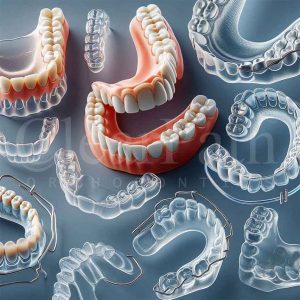
In the world of orthodontics, retainers play a crucial role in maintaining the alignment of teeth after orthodontic treatment.
But what exactly are retainers, and what do they do? Let’s delve into the details.
What are Retainers?
Dental professionals custom-make retainers as dental appliances to hold teeth in their new position after braces or any other method of realigning teeth.
They typically mold these retainers from clear plastic or wires to fit the patient’s mouth perfectly.
Types of Retainers
There are several types of retainers, each with its unique characteristics:
| Types of Retainers | Description |
| Hawley Retainers | These retainers are made of a combination of metal wires and sturdy acrylic designed to keep your teeth in place. The design is simple, with the wire going across the front of the teeth and the acrylic molded to fit the roof of the mouth. |
| Essix Retainers | Essix retainers are clear, removable retainers that fit over the entire arch of teeth. They are less noticeable than Hawley retainers and are often preferred for their aesthetic appeal. |
| Clear Retainers | Clear retainers are similar to Essix retainers but are made from a different type of clear plastic that is more durable and resistant to discoloration. |
The Primary Function of Retainers
The primary function of retainers is to maintain the position of your teeth after orthodontic treatment.
Once braces or aligners have moved your teeth into the desired position, retainers ensure they stay in place while the surrounding gums and bone adapt to the new alignment.
This is crucial because teeth have a natural tendency to drift back to their original position after orthodontic treatment, a phenomenon known as relapse.
Retainers are an essential part of orthodontic treatment. They ensure the long-term success of the treatment by preventing teeth from moving back to their original position.
Always remember to wear your retainer as instructed by your orthodontist to maintain your new, beautiful smile!
Retainers Vs Actual Aligners: Understanding the Difference
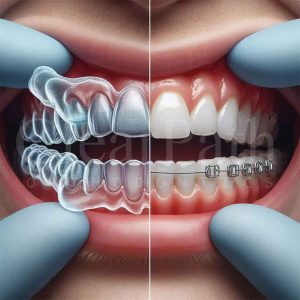
In the realm of orthodontics, two terms often come up: retainers and aligners.
While you might find them similar, they serve different purposes and are used at different stages of your orthodontic journey.
This guide will help you understand the difference between these two important dental appliances.
How Active Aligners Work
Dental professionals custom-make active aligners, such as clear aligners, into trays fabricated from clear plastic material.
They use these aligners as a replacement for conventional metal braces to correct poorly aligned teeth.
Aligners work by applying gentle pressure on the teeth, gradually moving them into the desired positions.
At the end of every wear cycle, which could be one or two weeks, you shift to the next step of aligners.
The Role of Retainers
Unlike aligners, dental professionals don’t design retainers to move teeth. Instead, they use them to maintain the position of your teeth once your aligners or braces have successfully aligned them.
This is because teeth have an inherent “elastic memory” and will tend to move back to their original position before treatment.
Wearing retainers for a few years after treatment can prevent this movement and maintain the alignment of your teeth.
The Key Difference
The biggest difference between retainers and aligners lies in their goals and the materials they are made from.
According to professionals Aligners are designed to enable teeth to move into a more desirable location through constant gentle forces.
On the other hand, retainers are designed to prevent teeth from moving. They are made from different materials and are not designed to be a long-term solution to keeping teeth in a finished state.
While both retainers and aligners play crucial roles in the journey to a perfect smile, they serve different purposes.
Aligners actively move your teeth to correct misalignments, while retainers maintain your teeth’s position after the treatment.
Understanding the difference between the two can help you make informed decisions about your orthodontic care.
Stay tuned for more informative guides on orthodontics and dental health. Until then, keep smiling!
Can Retainers Ever Straighten Teeth? A Reality Check
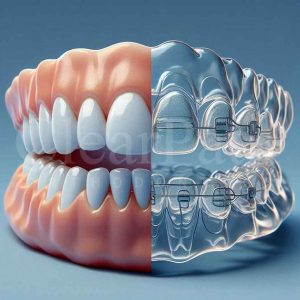
Orthodontic retainers are often associated with the maintenance of teeth alignment post-treatment.
But can they ever straighten teeth?
This guide aims to address this question and provide a clear understanding of the capabilities and limitations of retainers.
The Potential for Minor Adjustments
Retainers are primarily designed to hold teeth in their new position after orthodontic treatment.
However, in some cases, they might help with very slight post-treatment shifts. If a tooth has moved slightly out of its desired position, a retainer may be able to nudge it back.
This is particularly true for cases where the misalignment is minimal and the teeth just need a little guidance to get back on track.
The Limitations of Retainers
While retainers can make minor adjustments, it’s important to understand their limitations.
Retainers are not designed for significant corrections and cannot actively move teeth like braces or aligners.
They lack the necessary force that is required to move teeth in the jawbone.
Retainers are made to fit the current form of your teeth. If your teeth have significantly shifted from their post-treatment position, a retainer will not fit properly and will not be able to guide the teeth back to the desired position.
In such cases, a new orthodontic treatment may be necessary.
While retainers can potentially correct very minor shifts in teeth alignment, they are not a solution for significant teeth straightening.
Their primary role is to maintain the position of your teeth after orthodontic treatment.
If you notice a significant shift in your teeth alignment, it’s best to consult with your orthodontist to discuss the most appropriate treatment options.
Why Retainers are Crucial After Orthodontic Treatment
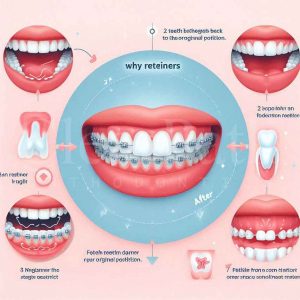
Orthodontic treatment is a significant investment in time, effort, and resources.
But the journey doesn’t end when the braces come off or the aligners are done. This is where retainers come in.
Let’s explore why retainers are an indispensable part of your orthodontic journey.
Bone Remodeling and the Role of Retainers
When your teeth move during orthodontic treatment, the bone around them changes shape in a process known as bone remodeling.
This process involves the removal of old bone tissue and the formation of new bone tissue.
Once your teeth have been moved into their desired positions, it takes some time for the bone to stabilize around the new tooth position.
This is where retainers come in. By holding your teeth in their new positions, retainers give your bone the time it needs to remodel and stabilize, effectively locking in the results of your orthodontic treatment.
The Risk of Teeth Shifting Without Retainers
Without the use of retainers, there’s a risk that your teeth could shift back towards their original positions, a phenomenon known as relapse.
This is because the elastic fibers in your gums can exert a pull on your teeth, causing them to move.
If your teeth do shift significantly, you might find yourself needing further orthodontic treatment to correct them.
This is why it’s so important to wear your retainers as instructed by your orthodontist.
Retainers are a crucial part of maintaining the results of your orthodontic treatment.
They allow your bone to stabilize around your newly aligned teeth and prevent unwanted tooth movement, ensuring that your new smile lasts a lifetime.
Remember, wearing your retainer is just as important as the treatment itself.
Why Retainers are Crucial After Orthodontic Treatment
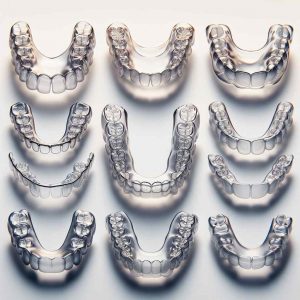
Orthodontic treatment is a significant investment in time, effort, and resources.
But the journey doesn’t end when the braces come off or the aligners are done. This is where retainers come in.
Let’s explore why retainers are an indispensable part of your orthodontic journey.
Bone Remodeling and the Role of Retainers
When your teeth move during orthodontic treatment, the bone around them changes shape in a process known as bone remodeling.
This process involves the removal of old bone tissue and the formation of new bone tissue.
Once your teeth have been moved into their desired positions, it takes some time for the bone to stabilize around the new tooth position.
This is where retainers come in.
By holding your teeth in their new positions, retainers give your bone the time it needs to remodel and stabilize, effectively locking in the results of your orthodontic treatment.
The Risk of Teeth Shifting Without Retainers
Without the use of retainers, there’s a risk that your teeth could shift back towards their original positions, a phenomenon known as relapse.
This is because the elastic fibers in your gums can exert a pull on your teeth, causing them to move.
If your teeth do shift significantly, you might find yourself needing further orthodontic treatment to correct them.
This is why it’s so important to wear your retainers as instructed by your orthodontist.
Retainers are a crucial part of maintaining the results of your orthodontic treatment. They allow your bone to stabilize around your newly aligned teeth and prevent unwanted tooth movement, ensuring that your new smile lasts a lifetime.
Remember, wearing your retainer is just as important as the treatment itself. Stay tuned for more informative guides on orthodontics and dental health.
Until then, keep smiling!
Alternatives to Retainers for Teeth Straightening
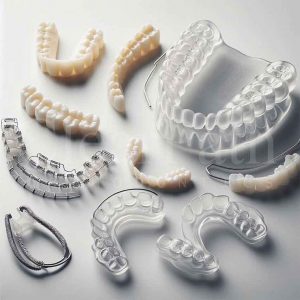
While retainers play a crucial role in maintaining the alignment of teeth post-treatment, they are not designed for significant teeth straightening.
For those seeking to correct misaligned teeth, there are several alternatives to consider. This guide will explore some of these options.
| Popular Orthodontic Treatments | Description |
| Traditional Braces | Traditional braces have been the go-to solution for correcting misaligned teeth for many years. They consist of metal brackets that are glued to your teeth and tied together by wires and tiny rubber bands. Over time, they apply pressure to your teeth, gradually moving them into the desired position. |
| Clear Aligners | Clear aligners, such as Invisalign, are a more modern solution for teeth straightening. They are virtually invisible and can be removed for eating, drinking, and cleaning. Like traditional braces, clear aligners work by applying controlled force to your teeth to move them into position. However, unlike braces, they are less noticeable and can be more comfortable to wear. |
Exploring Newer Options
Orthodontics is a field that continues to evolve, with new treatment options being developed regularly.
Depending on your individual needs and preferences, there may be other alternatives to retainers and traditional braces.
These could include lingual braces, which are placed on the back of your teeth, or palatal expanders, which are used to widen the upper jaw.
It’s always best to consult with an orthodontist to understand the best treatment options for your specific needs.
While retainers are essential for maintaining the results of orthodontic treatment, they are not designed for significant teeth straightening.
There are several alternatives available, including traditional braces and clear aligners, and potentially newer options based on individual needs.
Remember, every smile is unique, and what works for one person may not work for another.
Consulting an Orthodontist is Key: A Comprehensive Guide
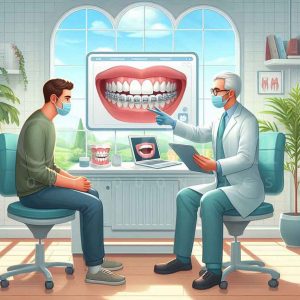
Orthodontic treatment is not a one-size-fits-all solution.
Each individual has unique dental needs and goals, making personalized evaluation and treatment planning crucial.
This guide emphasizes the importance of consulting an orthodontist for your orthodontic needs.
The Importance of a Personalized Evaluation
When it comes to orthodontic treatment, a personalized evaluation is key.
This involves a thorough examination of your teeth, jaw, and overall oral health. We recommend a consultation with a ClearPath-Ortho certified orthodontist for this evaluation.
ClearPath-Ortho certified orthodontists are trained professionals who specialize in diagnosing, preventing, and treating dental and facial irregularities.
The Role of an Orthodontist
An orthodontist can assess the extent of misalignment in your teeth and jaw.
They use various diagnostic tools, including X-rays, photographs, and dental impressions, to understand your specific needs.
Based on this assessment, they can recommend the most suitable treatment plan for you.
This plan could involve traditional braces, clear aligners, or other orthodontic appliances, depending on the complexity of your case.
The orthodontist will also provide you with an estimated treatment duration and cost.
Consulting an orthodontist is a crucial step in your orthodontic journey. They can provide a personalized evaluation and recommend the best treatment plan for your specific needs.
Remember, achieving a perfect smile is a team effort that involves you, your orthodontist, and consistent care and maintenance.
Wrapping Up: The Journey to a Perfect Smile
Throughout our discussion, we’ve learned that retainers play a crucial role in maintaining the position of teeth after orthodontic treatment.
They are designed to hold teeth in their new position, not to move them.
On the other hand, if you’re looking to straighten your teeth, orthodontic treatments like clear aligners or braces remain the gold standard.
These treatments are designed to apply controlled force to your teeth, gradually moving them into the desired position.
A Positive Note to End On
Achieving a beautiful smile is a journey, and it’s important to remember that there are safe and effective solutions available.
Whether you’re maintaining your post-treatment smile with a retainer or embarking on a teeth-straightening journey with braces or clear aligners, the result is a healthier, more confident you.
Remember, every smile tells a story, and with the right care and treatment, your smile can tell a story of health, confidence, and happiness.
Stay tuned for more informative guides on orthodontics and dental health. Until then, keep smiling!
If you’re intrigued by the prospect of unnoticeably straightening teeth (beautifying your smile without any stress!) With our FDA-Certified Clear Aligners and Retainers.
Please fill out the contact fom below.
We offer our services in both Pakistan and abroad. Our friendly customer service agents will reach out to guide you on the next steps.
All your information will be kept private.











